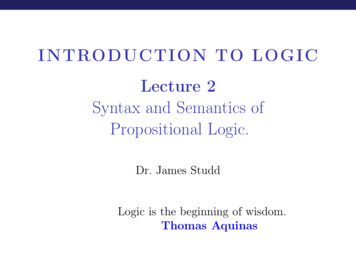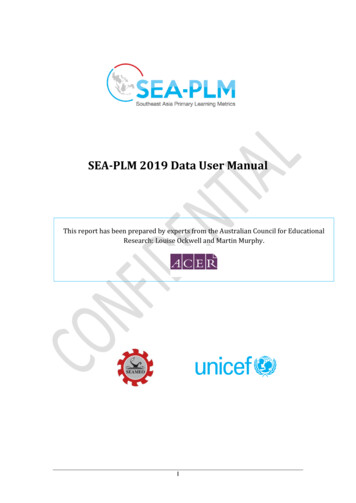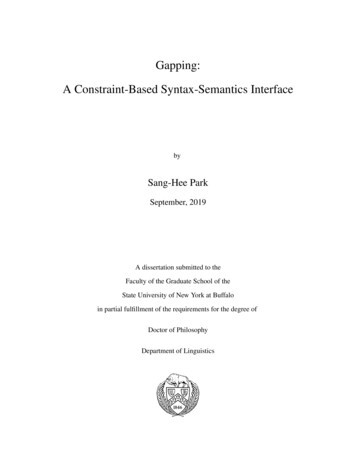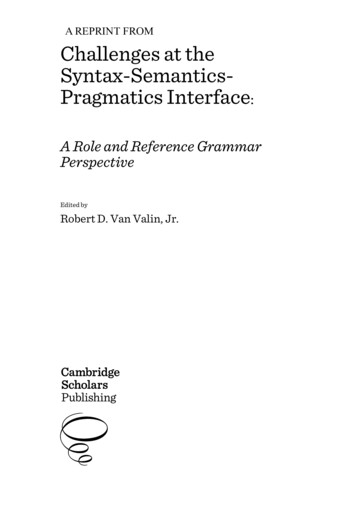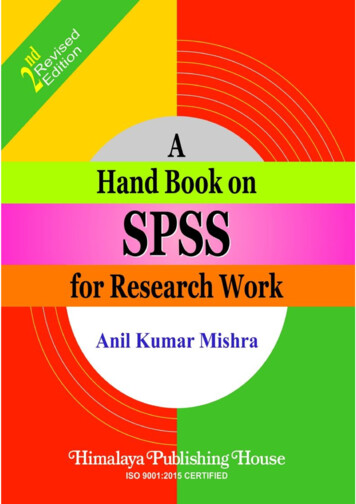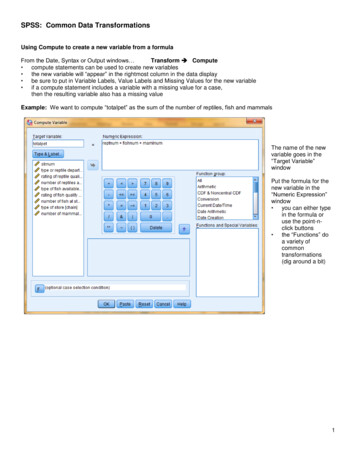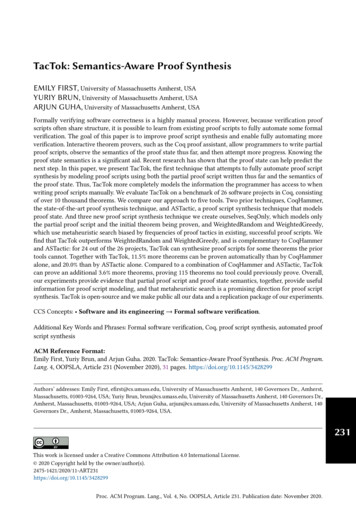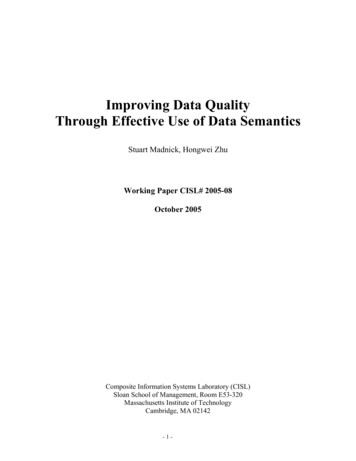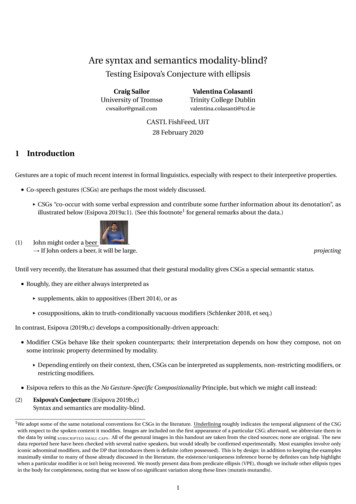
Transcription
Are syntax and semantics modality-blind?Testing Esipova’s Conjecture with ellipsisCraig SailorUniversity of TromsøValentina ColasantiTrinity College CASTL FishFeed, UiT28 February 20201 IntroductionGestures are a topic of much recent interest in formal linguistics, especially with respect to their interpretive properties.‚ Co-speech gestures (CSGs) are perhaps the most widely discussed.§ CSGs “co-occur with some verbal expression and contribute some further information about its denotation”, asillustrated below (Esipova 2019a:1). (See this footnote1 for general remarks about the data.)(1)John might order a beer.Ñ If John orders a beer, it will be large.projectingUntil very recently, the literature has assumed that their gestural modality gives CSGs a special semantic status.‚ Roughly, they are either always interpreted as§ supplements, akin to appositives (Ebert 2014), or as§ cosuppositions, akin to truth-conditionally vacuous modifiers (Schlenker 2018, et seq.)In contrast, Esipova (2019b,c) develops a compositionally-driven approach:‚ Modifier CSGs behave like their spoken counterparts; their interpretation depends on how they compose, not onsome intrinsic property determined by modality.§ Depending entirely on their context, then, CSGs can be interpreted as supplements, non-restricting modifiers, orrestricting modifiers.‚ Esipova refers to this as the No Gesture-Specific Compositionality Principle, but which we might call instead:(2)Esipova’s Conjecture (Esipova 2019b,c)Syntax and semantics are modality-blind.1 We adopt some of the same notational conventions for CSGs in the literature. Underlining roughly indicates the temporal alignment of the CSGwith respect to the spoken content it modifies. Images are included on the first appearance of a particular CSG; afterward, we abbreviate them inthe data by using SUBSCRIPTED SMALL CAPS . All of the gestural images in this handout are taken from the cited sources; none are original. The newdata reported here have been checked with several native speakers, but would ideally be confirmed experimentally. Most examples involve onlyiconic adnominal modifiers, and the DP that introduces them is definite (often possessed). This is by design: in addition to keeping the examplesmaximally similar to many of those already discussed in the literature, the existence/uniqueness inference borne by definites can help highlightwhen a particular modifier is or isn’t being recovered. We mostly present data from predicate ellipsis (VPE), though we include other ellipsis typesin the body for completeness, noting that we know of no significant variation along these lines (mutatis mutandis).1
Sailor & ColasantiAre syntax and semantics modality-blind?28 February 2020‚ Thus, the interpretive properties of a particular CSG (e.g. whether it projects / whether it is truth-conditionally vacuous) are determined only by how it composes;§ No special semantic status due to being a gesture per se.§ Gesturehood is just a PF property of Vocabulary Items, which are inserted late.‚ This approach is parsimonious, and appealing for the clear predictions it makes.§ E.g., CSGs should behave like their spoken counterparts with respect to phenomena that are sensitive to the atissue / non-at-issue divide (i.e. whether a piece of content makes a truth conditional contribution).This is where ellipsis comes in.‚ Ellipsis recovery seems able to freely ignore truth-conditionally vacuous content (except lexical presuppositions),while at-issue content is recovered obligatorily.§ This makes ellipsis a potentially valuable diagnostic for testing interpretive claims about CSGs.In this talk, we explore patterns of (non-)recovery of CSGs under ellipsis, using existing data and adding several newobservations.‚ We observe that when CSGs are forced to take a restricting (at-issue) reading, they are obligatorily recovered.§ In this respect, they behave exactly like truth-conditionally relevant content in the spoken modality.§ This can be taken as further support for Esipova’s Conjecture.‚ By the same token, CSGs can be ignored under ellipsis just in case they are truth-conditionally vacuous;§ Again, this is identical (modulo lexical presuppositions) to the behavior of non-at-issue content in the spokenmodality, as implied in the literature.These results are straightforwardly consistent with the composition-driven approach.2 Background: CSGs and the taxonomy of projecting vs. non-projecting contentCSGs have been the subject of much recent work, especially from the perspective of formal semantics and pragmatics(Ebert and Ebert 2014, Ebert 2014, 2017, Tieu et al. 2017, 2018, Zlogar and Davidson 2018, Schlenker 2018, Esipova 2018,2019a,b,c,d, Hunter 2019, a.o.; see Abner et al. 2015 for a general overview on gesture):‚ investigates the semantico-pragmatic contribution of gestures in spoken utterances, especially CSGs;‚ focuses on the gesture projection problem: if and how gestures can “project” out of (i.e., not be interpreted within) thescope of semantic operators, e.g. negation, conditionals, etc.;‚ (mostly) deals with iconic, non-conventionalized gestures (cf. Esipova 2019d, poster at LSA 2020);‚ generally agrees that gestures contribute projecting (truth-conditionally vacuous) inferences by default;‚ does not agree:§ on the mechanisms responsible for gestural projection;§ whether such behavior is intrinsic to their gestural modality.There are three main analyses concerning the interpretation of CSGs:2
Sailor & ColasantiAre syntax and semantics modality-blind?28 February 2020‚ the supplemental analysis (Ebert and Ebert 2014, Ebert 2014, 2017):§ claims that CSG are supplements (e.g. appositives; Potts 2005):(3)a.b.I brought a bottleLARGE to the talk.I brought a bottle, which (by the way) was this largeLARGE , to the talk.§ implies that the projection profile of gestures is determined by their co-speech status.‚ the cosuppositional analysis (Schlenker 2018; see also Tieu et al. 2017, 2018):§ claims that CSG are cosuppositions (i.e. assertion-dependent presuppositions; Schlenker 2018)(4)a.b.John might order a beerLARGE .If John orders a beer, it will be large.§ also implies that the projection profile of gestures is determined by their co-speech status.‚ the composition-driven analysis (Esipova 2018, 2019a,b,c,d):§ claims that CSGs are defined by the way they project, which is determined by how they compose;§ deals with iconic (non-conventionalized) and non-iconic (conventionalized) gestures;§ implies that the projection profile of gestures is not determined by their co-speech status; i.e. they are bona fidelinguistic objects irrespective of their modality;§ means that CSGs can be either restrictive modifiers, non-restrictive modifiers, or supplements; i.e., it capturesseveral different interpretations.‚ This taxonomy is illustrated below in Table 1 (see also Leffel 2014):Table 1: Modifiers vs supplements (adapted from Esipova -at-issue)truth-conditionally non-vacuoustruth-conditionally vacuoustruth-conditionally vacuousnon-projectingprojectingprojectingExample (5)Example (6)Example (7)(5)Restricting modifier (Esipova 2019d:555)3I should be eating less saturated fats and more healthy fats.Û I should be eating less fats and more fats.Û All fats are {saturated, healthy}.(6)Non-Restricting modifier (Esipova 2019d:555)Context: The speaker believes that processed meat causes cancer.I shouldn’t be eating so many deadly hot dogs.Ñ I shouldn’t be eating so many hot dogs.Ñ All hot dogs are deadly.2 Certain other readings are possible in principle (e.g. non-projecting non-restricting), but we omit them here as they are degraded or unacceptable(see Esipova 2019a for experimental results to this effect).3 Bold indicates focal stress. See Leffel (2014), Esipova (2019b:38-39), and further below on the role of contrastive focus in bringing out restrictingreadings for modifiers (gestural and otherwise).3
Sailor & Colasanti(7)Are syntax and semantics modality-blind?28 February 2020Supplement (adapted from Esipova 2019d:554)I will invite Zoe, (who is) a stuntwoman.Ñ I will invite Zoe.Ñ Zoe is a stuntwoman.In what follows, we adopt the taxonomy and terminology in Table 1.3 Ellipsis and CSGsEllipsis is subject to a condition on recovery/identity.‚ Intuitively: an E(llipsis)-site is in some way “identical” to its A(ntecedent).‚ This has been stated both as a semantic requirement, and as a syntactic one (see Merchant 2018a for an overview):§ Proponents of a semantic approach point to cases of syntactic non-identity between E-site and antecedent (e.g.vehicle change: I didn’t see anybody, but Sue did [–].)§ Proponents of a syntactic approach are concerned with connectivity effects:‚ Signs that material outside an ellipsis site is syntactically related to ellipsis-internal material, as specified inits antecedent (e.g. case matching, P-stranding sensitivity, etc.)§ Some approaches incorporate aspects of both (e.g. semantic accommodation of mismatched antecedents constrained by syntax: Thoms 2015)That being said, certain types of meaning can apparently be ignored when recovering an E-site.3.1 Ellipsis and non-restricting CSGsTo our knowledge, Schlenker (2015) is the first to ask how CSGs behave with respect to ellipsis.‚ On the basis of a single example, he notes that CSGs can be ignored under ellipsis:4(8)Context: I had two guys standing in front of me, one of them very short and the other one very tall.The tall one allowed me to remove his glasses, but the short one didn’t [–].Û The short person’s glasses were high up‚ The ellipsis site here can be resolved as though the elided nominal glasses is completely unmodified (i.e., they are notinterpreted as being high up, or in any other particular location).§ Since this inference from the antecedent CSG is not part of the E-site, we can say that ellipsis here “ignores” theantecedent CSG.Crucially, this example involves a non-restricting reading of the CSG.‚ We will return to this shortly.4 In fact Schlenker’s (2015) claim is broader than this: he claims that CSGs can be ignored in the focus dimension generally, on the basis of an exampleshowing that calculation of focus alternatives under only behaves in a similar way (see Schlenker and Chemla 2018:§2 and Esipova 2019b:§7.2.2for related discussion). We leave this intriguing connection aside, as well as the potential connection to attitude reports proposed in Esipova(2019b:169), but acknowledge that these are worthy avenues of future research.4
Sailor & ColasantiAre syntax and semantics modality-blind?28 February 2020Esipova (2019b:§7.2.2) adds others, including one involving an adverbial modifier (rather than the adnominal ones thatthe literature, and we, focus on):(9)Context: Zoe and Kim are participating in a multi-sport competition. For the shooting part of the competition,participants had to choose a longbow or a gun and then shoot at the target.Zoe has already shot at the target, but Kim hasn’t [–].Û If Kim shoots at the target, she’ll shoot a longbow.A brief aside: if Esipova’s Conjecture is correct – as we suspect it is – and syntax is modality blind,‚ Then modifier CSGs will be merged in normal adjoined positions (e.g. as manner adverbs/PPs adjoined to VP), justlike their spoken counterparts.‚ This raises a potential confound for examples such as (9) which bears some attention.‚ The confound is relevant for all cases where the putative “ignored” content is construed as a modifier of XP in thecontext of XP ellipsis (vs. ellipsis of some higher YP).§ That is, modified VPs in the context of VPE, modified NPs in the context of NPE, etc.‚ The issue: the absence of the modifier in the E-site’s interpretation might not be due to it being ignored in the relevantway (i.e. due to its projecting status).§ .but because a smaller, unmodified XP is able to serve as the antecedent, instead.(10). . . [XPADJUNCT [XPX [YP . . . ] ]]‚ Certain independent factors might influence the antecedent choice (e.g. see Sailor 2014:§1.4.3 and Moulton 2019 onVPE), but the point stands.§ To avoid this, examples should be constructed so the modified constituent and the elided constituent cannot bethe same.Back to the main thread: we provide examples from other ellipsis types (NPE and TPE) for completeness:‚ These behave as VPE does: non-restricting CSGs can be ignored under ellipsis.(11)Context: John has only one dog, and it is large. Sam also has only one dog, but it is small.NPEWe heard some of John’s stories about his dogLARGE , but we didn’t hear any of Sam’s [–], which is surprising becausehe’s obsessed with that little thing.Û Sam’s dog is large(12)Context: we both know Mary has only one dog.A:B:TPEI wonder whereI Mary’s dogSMALL is t I .In the kitchenI [–], but he’s actually enormous now.Û Mary’s dog is smallSo, CSGs can be ignored under ellipsis when they are non-restricting.‚ In this respect, they behave exactly like other non-restricting content with respect to ellipsis recovery.‚ For example, expressives, appositives, and even non-restricting adjectives can be ignored:(13)Expressives (Potts et al. 2009:§5)A:I saw your fucking dog in the park.5
Sailor & ColasantiB:(14)Are syntax and semantics modality-blind?28 February 2020No, you didn’t [–]; you couldn’t have [–]. The poor thing passed away last week.Û B dislikes their own dogAppositives (Esipova 2019b:168)Stephanie brought her dog, (which is) a large beast, to the party, but Lucy didn’t [–].Û Lucy’s dog is a large beast(15)Non-restricting adjectives (see also ibid.)a.b.c.Context: Mary has only one dog, as does B.VPEA: Mary won’t be bringing her obnoxious dog to the party, as one of the guests is allergic.B: Ah okay, then I won’t [–] either.Û B believes their dog is obnoxiousContext: John has only one dog, and it is large. Sam also has only one dog, but it is small.NPEWe heard some of John’s stories about his enormous dog, but we didn’t hear any of Sam’s [–], which is surprising because he’s obsessed with that little thing.Û Sam’s dog is enormousContext: we both know Mary has only one dog.TPEA: I wonder whereI Mary’s obnoxious dog is t I .B: In the kitchenI [–], but he’s actually really nice.5Û Mary’s dog is obnoxious‚ These are all non-restricting in context, and therefore truth-conditionally vacuous.§ The silhouette of a generalization begins to emerge:(16)Truth-conditionally vacuous material present in A can be excluded from the interpretation of E.6But this is immediately contradicted by the behavior of several different kinds of presuppositions (Esipova 2019b:167):(17)a.Jackie stopped smoking, but Daisy didn’t [–].Ñ Daisy used to smoke.b.c.O-Ren knows that she is in danger, but Vernita doesn’t [–].Ñ Vernita is in danger. (sloppy)Kim regrets cheating on the exam, but Abernathy doesn’t [–].Ñ Abernathy cheated on the exam.‚ However, what unites all of these presuppositions is that they are lexical:§ They arise as part of the lexical meaning of stop, know, regret, etc.§ This is evidently an important distinction when it comes to distinguishing the sort of truth-conditionally vacuousmaterial that can and cannot be ignored under ellipsis.‚ Perhaps the generalization in (16) is on track, then, so long as lexical presuppositions are excepted.7‚ The updated statement would then be:(18)With the exception of lexical presuppositions, truth-conditionally vacuous material present in A can be excludedfrom the interpretation of E.5 These have the general character of the cases discussed in Lipták (forthcoming), which she argues to involve mixed quotation (such that the ellipsissite has an instance of the element being corrected, albeit a quoted one, meaning no contradiction arises). However, her cases all involve correctionof the verb, while ours involve an adnominal modifier. Still, we would ideally like to exclude the possibility of a mixed quotation analysis here. Thiswill have to wait until we can determine what (if any) predictions such a powerful system makes.6 There may also be cases where such material must be excluded. For example, AnderBois (2011) notes that appositive-internal content cannot serveas the antecedent for sluicing (cf. VPE), though some of those empirical points are debated in the literature.7 We can imagine various ways of implementing this; see Appendix A.6
Sailor & ColasantiAre syntax and semantics modality-blind?28 February 2020This is a striking generalization, and we suspect it may not hold up.‚ But even if it captures a strong tendency, it is worth pursuing futher.We turn now to the behavior of truth-conditionally relevant modifiers under ellipsis, starting with CSGs.3.2 Ellipsis and restricting CSGsTo our knowledge, it has not been previously noted that CSGs are recovered obligatorily under ellipsis just in case theyreceive a restricting reading in context.8‚ The literature has mostly relied on contrastive focus to force restricting readings for CSGs, so we start there:(19)Context: Julia owns two dogs, a small one and a big one.Julia won’t bring her dogSMALL , but she might bring her dogLARGE . If she does [–], we’re going to need a bigger car.‚ This is only coherent if the ellipsis site is recovered with the restricting CSG in the antecedent.§ Thus, this CSG cannot be ignored under ellipsis, which we take to be because of its restricting (at-issue) status.Putting ellipsis aside for a moment, it is also possible to get restricting readings for CSGs in non-contrastive contexts:(20)Context: we are packing for a trip. We own two coolers, one small and one large, and we both know this fact.I just had an idea: if we bring our coolerLARGE , we could pack all our booze.‚ The CSG in (20) is restricting: it picks out which of the two coolers I want to bring.§ A non-restricting reading would generate a false uniqueness inference, given the context.‚ This restricting reading is required solely by the context; contrastive focus is not responsible.§ Consider the intonation of its verbal counterpart: nuclear stress falls on cooler, not on large.9(21)Context: same as (20)I just had an idea: if we bring our [large cóóler], we could pack [all our bóóze].‚ If any constituent is focused here, it is at least as large as the whole DP; the modifier itself is not focused. This isimportant:§ The nascent literature relies on (contrastive) focus to force at-issue interpetations for CSGs (Esipova 2018, 2019a).‚ With good reason: focused material is almost always at-issue (see esp. Leffel 2014 and Esipova 2019b:38-39)‚ Our point: focus may be a sufficient condition for bringing out such readings, but not a necessary one.Getting back to ellipsis: the above is especially relevant given that non-contrastive restricting CSGs are recovered obligatorily (like the contrastive ones):(22)Context: same as (20)A:B:I just had an idea: let’s [bring our coolerLARGE ].If we do [–], we could pack all our booze! (It won’t all fit in the small one.)8 Schlenker and Chemla (2018:620) note this effect for pro-speech gestures. The fact that the pro-speech vs. co-speech distinction is not relevanthere (in ellipsis contexts when both are restricting) is of course entirely consistent with Esipova’s composition-driven approach.9 Prosodic prominence is not always a reliable diagnostic for semantic focus, as Ahn and Sailor (2018) discuss in detail; however, the confoundingfactors they discuss are not obviously involved here.7
Sailor & ColasantiAre syntax and semantics modality-blind?28 February 2020‚ Elided material cannot be focused, and indeed must be entirely given.10§ This tells us that it is the restricting status of the antecedent CSG that determines whether the E-site CSG getssuch an interpretation.Additional examples are below:(23)Context: Zoe and Kim are participating in a multi-sport competition. For the shooting part of the competition,participants had to choose a longbow or a gun and then shoot once at the target. Both Zoe and Kim were ready toshoot.Zoe was [going to shoot at the targetLONGBOW ], but Kim wasn’t [–]: she was using her gun instead.Û When Kim shoots at the target, she’ll shoot a longbow.‚ In context, the ellipsis site cannot be interpreted without the CSG.§ If it were, the result would be Kim wasn’t going to shoot at the target, which is contradicted by both the contextand the elaboration.(24)Context: for the shooting part of the competition, participants first shoot a longbow once and then a gun once.If Zoe [hits the bullseye when she shootsLONGBOW ], I’ll give you 10. If she doesn’t [–], I won’t bet on her gun shooting.So CSGs are obligatorily recovered just in case they are restricting.‚ This is not surprising: restricting modifiers make at-issue (truth-conditionally relevant) contributions.§ Such information cannot be ignored by the ellipsis recovery procedure.This data in this section support the compositionally-driven approach:‚ CSGs behave just like their spoken counterparts in the above respect.‚ In other words, spoken modifiers are (unsurprisingly) recovered obligatorily when they are at-issue:(25)Context: we are packing for a trip. We own two coolers, one small and one large, and we both know this fact.A:B:I just had an idea: let’s [bring our large cooler].If we do [–], we could pack all our booze! (It won’t all fit in the small one.)Again, we see no relevant difference between CSGs and their spoken counterparts as far as ellipsis is concerned.4 ConclusionIn sum, the composition-driven approach to CSGs predicts that they should pattern like their spoken counterparts in thesame contexts.‚ This is brought out clearly with ellipsis, as it seems sensitive to the at-issue / non-at-issue distinction.‚ Our tentative conclusion is the following:§ Non-at-issue (projecting, truth-conditionally vacuous) content – including CSGs – can be ignored under ellipsis.§ At-issue (non-projecting, truth conditional) content – including CSGs – cannot be ignored under ellipsis.10 See Merchant (2018b:§5) for recent refinement of this point, with provisos that don’t bear on the present point.8
Sailor & ColasantiAre syntax and semantics modality-blind?28 February 2020ReferencesAbner, Natasha, Kensy Cooperrider, and Susan Goldin-Meadow. 2015. Gesture for linguists: a handy primer. Languageand Linguistics Compass 9:437–449.Ahn, Byron, and Craig Sailor. 2018. Principled mismatches in the mapping from semantics to prosody. Presented at the2018 Annual Meeting of the LAGB, University of Sheffield. Available at: AnderBois, Scott. 2011. Issues and alternatives. Doctoral Dissertation, UC Santa Cruz.Ebert, Cornelia. 2014. The semantic impact of co-speech gestures. Presented at Embodied meaning goes public –gestures, signs, and other visible linguistic effects of simulation processes, University of Stuttgart. Available online iment-stuttgart.pdf, December 2014.Ebert, Cornelia. 2017. Co-speech vs. post-speech gestures. Presented at Language and cognition workshop in memory ofPeter Bosch, February 2017.Ebert, Cornelia, and Christian Ebert. 2014. Gestures, demonstratives, and the attributive/referential distinction. Talkgiven Semantics and Philosophy in Europe (SPE 7), Humboldt-Universität zu Berlin.Esipova, Maria. 2018. Focus on what’s not at issue: Gestures, presuppositions, supplements under contrastive focus. InProceedings of Sinn und Bedeutung 22, ed. Uli Sauerland and Stephanie Solt, 385–402.Esipova, Maria. 2019a. Acceptability of at-issue co-speech gestures under contrastive focus. Glossa 4: 35. 1–22.Esipova, Maria. 2019b. Composition and projection in speech and gesture. Doctoral Dissertation, NYU.Esipova, Maria. 2019c. Composition and projection of co-speech gestures. In Proceedings of SALT 29, ed. Katherine Blake,Forrest Davis, Kaelyn Lamp, and Joseph Rhyne, 117–137. Linguistic Society of America.Esipova, Maria. 2019d. Towards a uniform super-linguistic theory of projection. In Proceedings of the 22nd AmsterdamColloquium, ed. Julian J. Schlöder, Dean McHugh, and Floris Roelofsen, 553–562.Fiengo, Robert, and Robert May. 1994. Indices and identity. Cambridge, MA: MIT Press.Hunter, Julie. 2019. Relating gesture to speech: reflections on the role of conditional presuppositions. Linguistics andPhilosophy 42:317–332.Katzir, Roni. 2007. Structurally-defined alternatives. Linguistics and Philosophy 30:669–690.Leffel, Timothy. 2014. The semantics of modification: adjectives, nouns, and order. Doctoral Dissertation, NYU.Lipták, Anikó. Forthcoming. Fragments with correction. Linguistic Inquiry 1–14.Merchant, Jason. 2001. The syntax of silence: Sluicing, islands, and the theory of ellipsis. Oxford University Press.Merchant, Jason. 2018a. Ellipsis: A survey of analytical approaches. In The Oxford handbook of ellipsis, ed. Jeroen vanCraenenbroeck and Tanja Temmerman, chapter 2, 19–45. Oxford University Press.Merchant, Jason. 2018b. Verb-stranding predicate ellipsis in Greek, implicit arguments, and ellipsis-internal focus. In Areasonable way to proceed: essays in honor of Jim McCloskey, ed. Jason Merchant, Line Mikkelsen, Deniz Rudin, andKelsey Sasaki, 229–270. Available online at https://escholarship.org/uc/item/7z29n70x.Moulton, Keir. 2019. Adverbs in VP ellipsis: an experimental investigation of antecedent selection. Canadian Journal ofLinguistics 64:475–508.Potts, Christopher. 2005. The logic of conventional implicatures. Oxford University Press.Potts, Christopher, Ash Asudeh, Seth Cable, Yurie Hara, Eric McCready, Luis Alonso-Ovalle, Rajesh Bhatt, ChristopherDavis, Angelika Kratzer, Tom Roeper, and Martin Walkow. 2009. Expressives and identity conditions. Linguistic Inquiry40:356–366.Sailor, Craig. 2014. The variables of VP ellipsis. Doctoral Dissertation, UCLA.Schlenker, Philippe. 2015. Gestural presuppositions. Snippets 30:9–11.Schlenker, Philippe. 2018. Gesture projection and cosuppositions. Linguistics and Philosophy 41:295–365.Schlenker, Philippe, and Emmanuel Chemla. 2018. Gestural agreement. Natural Language & Linguistic Theory 36:587–625.Thoms, Gary. 2015. Syntactic identity, parallelism and accommodated antecedents. Lingua 166:172–198.Tieu, Lyn, Robert Pasternak, Philippe Schlenker, and Emmanuel Chemla. 2017. Co-speech gesture projection: Evidencefrom truth-value judgment and picture selection tasks. Glossa: A Journal of General Linguistics 2:102.Tieu, Lyn, Robert Pasternak, Philippe Schlenker, and Emmanuel Chemla. 2018. Co-speech gesture projection: Evidencefrom inferential judgments. Glossa: A Journal of General Linguistics 3:109.Zlogar, Christina, and Kathryn Davidson. 2018. Effects of linguistic context on the acceptability of co-speech gestures.Glossa: A Journal of General Linguistics 3:73.9
Sailor & ColasantiAre syntax and semantics modality-blind?28 February 2020A PPENDICESA Implications for ellipsis identitySchlenker and Chemla (2018) suggest that the ignoring of (non-restricting) CSGs under ellipsis is akin to the kinds ofeffects seen in what are known as vehicle change contexts (Fiengo and May 1994):(26)I turned in my assignment, but most of the other students didn’t [turn in their assignment].‚ But the comparison is not straightforward:§ While the individual phi-featural specifications are ignored, the phi bundle itself is still taken to be present, andevidently cannot be ignored.§ We may see a change/substitution of feature specifications in vehicle change contexts, but not wholesale ignoringof the phi-bearing element/position (see Fiengo and May 1994:ch. 5 for extensive discussion).§ That said, the effect we see above with e.g. expressives is not obviously reducible to simple substitution of particular featural specifications:‚ There is no feature on fucking that could be subsituted during recovery such that the resulting interpretationis that B feels no animus toward their own dog.11‚ Rather than undergoing some kind of substitution of feature specifications, the content discussed here simply seemsto play no role in the recovery procedure whatsoever.§ It looks like the element and/or its position really is ignored, unlike with phi-bundles in vehicle change contexts.But how does this ignoring of non-at-issue modifiers work with respect to the identity condition on ellipsis?‚ As long as the procedure for calculating semantic identity is able to ignore such material (but not lexical presuppositions, perhaps by lexical integrity), there is no problem on the semantic side.§ This could perhaps be made to fall out from the focus dimension implicated by e-GIVENness (Merchant 2001).‚ But there would still be a problem on the syntactic side (see above on why we need to care about syntactic identity).§ If an antecedent contains non-at-issue content that is not present in the E-site by way of being “ignored”, thenthat E-site is not syntactically identical to that antecedent (on the assumption that we don’t have non-overt,syntactically-present counterparts to each type of ignorable content).‚ However, the theory of antecedent accommodation in Thoms (2015) may provide a way of satisfying both semanticand syntactic identity requirements in these cases.§ An antecedent A that is semantically identical (modulo non-at-issue content, we propose) to an E-site may differsyntactically from that E-site so long as an alternative of A can be generated whose syntax does match.§ While Thoms only discusses the generation of such alternatives involving substitution of a particular node withanother, his system (built on that of Katzir 2007) allows deletion of nodes as well.‚ Perhaps the instances we discuss here of ignored non-at-issue content are examples of just such deletioncases, not previously observed.11 See Potts (2005:168) on the ‘bad’ function in the meaning of expressives, and the possibility of a positive counterpart of expressives like fucking(e.g. brilliant in Britis
Sailor & Colasanti Are syntax and semantics modality-blind? 28 February 2020 (7) Supplement (adapted from Esipova 2019d:554) I will invite Zoe, (who is) a stuntwoman. ÑI will invite Zoe. ÑZoe is a stuntwoman. In what follows, we adopt the taxonomy and terminology in Table 1. 3Ellipsis and CSGs Ellipsis is subject to a condition on recovery .
